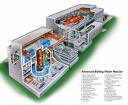| Surety Bonds for Nuclear Energy Facility Construction Cost-Savings |
|
Suggested Reading: This was written for those with an interest in cost-savings for construction of nuclear energy facilities. This may include owners, contractors, financiers, regulatory bodies, third-party intervenors or consumers intermittently referred to here as "the industry" or "we" for brevity. It is also recommended to the surety market. |
Executive Summary: The nuclear industry should consider the pro-active use of surety bonds as a contract strategy to obtain financing, control costs, demonstrate prudence and enhance project management.
| ||||||||
Many have noticed that the press never seems to miss an opportunity to run a negative story about the cost of nuclear energy while overlooking its well-established safety and environmental benefits. The New York Times article was only the first of its kind. That said, nuclear construction costs are an easy and fair target, certainly news fit to print. Luke 14:28 notwithstanding, it is impractical and even imprudent to venture beyond a fully-caveated best estimate for the cost of a new nuclear energy facility. But the emphasis in the media on this topic is obvious and the public may be left with a half-formed impression that each new project is being underwritten with their blank check. This logic may well extend to the renaissance as a whole and can easily be dissuaded, at least in my view. As David Haarmeyer has written in Nuclear New Build Cost Visibility and Predictability [9], a sound contract strategy is key in securing project financing. Significant weight is given by investors, banks, underwriters, creditors and guarantors to the proportion which is fixed, i.e., the performance costs, aka construction liability capped. Contract strategy is reviewed by the Department of Energy (DOE) on behalf of the taxpayers in its all-important, often make-or-break, loan guarantee programs.  Haarmeyer writes, "The contract strategy chosen and the owners' role in executing it will be closely scrutinized by institutions that look to finance the new nuclear plant build because these institutions will have the reasonable expectation that their investment can be financed." [9] I would add that capping fixed prices where possible with surety bonds and pro-actively managing the liability might also be emphasized as part of a good strategy. He continues, "How will the owners of the next generation nuclear power plants address price uncertainty and ensure risks and costs are properly allocated? The simple answer is that, compared to the past, owners must take a more proactive, informed and disciplined approach in the capital project process. To accomplish this, owners must take advantage of approaches and tools that enable them to facilitate collaboration among all parties, leverage competition whenever possible, increase transparency and capture project procurement information." [9] (Emphasis mine.) Surety bonds fit right into that scheme. Haarmeyer writes, "The contract strategy chosen and the owners' role in executing it will be closely scrutinized by institutions that look to finance the new nuclear plant build because these institutions will have the reasonable expectation that their investment can be financed." [9] I would add that capping fixed prices where possible with surety bonds and pro-actively managing the liability might also be emphasized as part of a good strategy. He continues, "How will the owners of the next generation nuclear power plants address price uncertainty and ensure risks and costs are properly allocated? The simple answer is that, compared to the past, owners must take a more proactive, informed and disciplined approach in the capital project process. To accomplish this, owners must take advantage of approaches and tools that enable them to facilitate collaboration among all parties, leverage competition whenever possible, increase transparency and capture project procurement information." [9] (Emphasis mine.) Surety bonds fit right into that scheme.
Surety bonds compliment the approaches and tools Haarmeyer goes on to describe in the article, excerpted below. Here's how. The SIO writes, "Surety companies are well positioned to analyze and manage construction risks because of their close relationships with contractors and surety bond producers. The surety bond producer works with contractors to prepare the necessary documentation for the rigorous pre-qualification process conducted by the surety company. Through the pre-qualification process,  the surety verifies the contractor's ability to perform the contract and fulfill its financial obligations (taking into account the contractor's current and projected commitments)." [2] In other words, the surety performs an at-risk pre-qualification at the micro-level for each and every construction contract bond they issue. Pre-qualification is a method widely understood and utilized in nuclear construction for big-ticket items, but taken only so far, e.g., fabrications, specialty contractors and suppliers. It is not necessarily performed on an ongoing, contract-by-contract basis. Surety bonds can do this, albeit not for the entire scope of work, but certainly for the less complex and easily-defined work packages. However, those very items may well have unforeseen impact and simply obtaining a surety bond is not a panacea. It is said, the Devil is in the details. the surety verifies the contractor's ability to perform the contract and fulfill its financial obligations (taking into account the contractor's current and projected commitments)." [2] In other words, the surety performs an at-risk pre-qualification at the micro-level for each and every construction contract bond they issue. Pre-qualification is a method widely understood and utilized in nuclear construction for big-ticket items, but taken only so far, e.g., fabrications, specialty contractors and suppliers. It is not necessarily performed on an ongoing, contract-by-contract basis. Surety bonds can do this, albeit not for the entire scope of work, but certainly for the less complex and easily-defined work packages. However, those very items may well have unforeseen impact and simply obtaining a surety bond is not a panacea. It is said, the Devil is in the details.
At this point, it should rightly be acknowledged this is "preaching to choir" for some of you, mainly the general contractors. It is also recognized that, on the macro-level, this may be built-in to the fixed-price scenarios. The purpose here is simply to "raise awareness" about how surety bonds can be used pro-actively, and to encourage a stepped-up, if not aggressive strategy, both for cost control and project management. Too often the surety bond is seen as a contract line-item, a checked-box until the shinola hits the fan.  That said, surety bonds are perhaps the most underutilized, inexpensive most cost-efficient risk mitigation available and their inherent value has been long-recognized within the regulations of the Nuclear Regulatory Commission (NRC). [10] Surety bonds are utilized extensively by large owners such as federal agencies, states, and municipalities, but perhaps less-so by the utilities, especially in the last 20-30 years. To the extent surety bonds will be used, it might as well be in an optimized, pro-active, disciplined and informed manner. Due to the first-of-a-kind (FOAK) character of the renaissance and the heightened current public scrutiny of expenditures, it is worthy of serious consideration. After all, "Whatever is worth doing at all is worth doing well."[11] As anyone in the admittedly insular surety claims world can tell you, the surety bond is too often an afterthought, rarely used in real-time by project management.
That said, surety bonds are perhaps the most underutilized, inexpensive most cost-efficient risk mitigation available and their inherent value has been long-recognized within the regulations of the Nuclear Regulatory Commission (NRC). [10] Surety bonds are utilized extensively by large owners such as federal agencies, states, and municipalities, but perhaps less-so by the utilities, especially in the last 20-30 years. To the extent surety bonds will be used, it might as well be in an optimized, pro-active, disciplined and informed manner. Due to the first-of-a-kind (FOAK) character of the renaissance and the heightened current public scrutiny of expenditures, it is worthy of serious consideration. After all, "Whatever is worth doing at all is worth doing well."[11] As anyone in the admittedly insular surety claims world can tell you, the surety bond is too often an afterthought, rarely used in real-time by project management.
 All too often when trouble arises, owners expect immediate unrealistic results and become dismayed and frustrated by the complexity of process. [12] As with any methodology, as Haarmeyer writes of Open Book Pricing Process (OBPP) the "[k]ey to making this approach work is an open collaboration between the owner and contractor to get transparency into each major cost line item, including contingency and escalation assumptions. This requires extensive active "due diligence" by the owner into the contractor's costs estimates. As a fluid and open process, the successful application of OBPP involves continual benchmarking, analysis and estimate reviews to establish a target price that reflects an appropriate risk allocation between the owner and EPC contractor. " [9] With the pro-active use of surety bonds, a similar relationship can be envisioned vis-a-vis the sureties.
All too often when trouble arises, owners expect immediate unrealistic results and become dismayed and frustrated by the complexity of process. [12] As with any methodology, as Haarmeyer writes of Open Book Pricing Process (OBPP) the "[k]ey to making this approach work is an open collaboration between the owner and contractor to get transparency into each major cost line item, including contingency and escalation assumptions. This requires extensive active "due diligence" by the owner into the contractor's costs estimates. As a fluid and open process, the successful application of OBPP involves continual benchmarking, analysis and estimate reviews to establish a target price that reflects an appropriate risk allocation between the owner and EPC contractor. " [9] With the pro-active use of surety bonds, a similar relationship can be envisioned vis-a-vis the sureties.

As described above by Haarmeyer, in order to obtain project financing, it is desirable to present the costs as fixed or capped to the maximum extent possible. I would suggest that a systemic and deliberate surety strategy benefits that effort immeasurably. However, once financing is secured, project delivery as promised becomes the priority at-hand. As the construction-types reading know, ground has been already broken for Plant Vogtle Units 3 and 4 in Georgia. Here again, he weighs in that "[i]n previous infrastructure build cycles, owners depended on fixed price ("lump sum") EPC contracts to shift most, if not all, engineering, procurement and construction risk to contractors. This contract strategy is still prevalent, but mostly only in name. "[9] Whether this is the perception or reality depends on the project. It may consist of easily-scoped, discrete, bondable work-packages as well. So, the glass may be half-full, depending upon your perspective. Those suddenly thrust into the spotlight know that this the most challenging part, the time to put-up or shut-up and perform.  The difficulty dealing with construction project management considerations such as competition for scarce resources and competition for concurrent new builds cannot be underestimated. These kinds of problems aren't solved simply by having the money to throw at them, as a completing surety can attest. Haarmeyer advises, "...the current sellers' markets in services, components and materials have significant risks and cost implications for building new nuclear plants. The global construction boom, which includes building facilities in the electric power industry as well as in the oil and gas, metals, manufacturing and other sectors, is putting unprecedented pressure on commodity, component and service prices, adversely impacting owner supply chains. Demand for E&C services is so great that firms can be selective in the projects they take, lessening competition for projects and the owner's ability to shift risks to contractors. Thus, the current sellers' market puts owners at a distinct disadvantage when negotiating contracts, which can lead to owners shouldering more risk. Moreover, without taking sufficient safeguards, owners may even pay EPC contractors more--higher EPC premiums-to assume less risk." [9] In turn, pro-active use of bonding shifts much of that effort to the surety. The surety assumes that risk for a relatively small premium. Properly administered, the surety can also be used to help hold contractor and surety to cost and schedule in real time. Similarly, becoming engaged with the surety will likely cause it to underwrite in a more informed manner, which ultimately keeps the premium they've earned from being being lost on claims. Bear in mind that the sureties haven't seen many nuclear construction bonds cross their desk lately, and may be less-than-prepared. It has been 20-30 years for them, too. Surety folks, before you have a LOCA* concerning all this, there is post coming soon for you as well, at [13].
The difficulty dealing with construction project management considerations such as competition for scarce resources and competition for concurrent new builds cannot be underestimated. These kinds of problems aren't solved simply by having the money to throw at them, as a completing surety can attest. Haarmeyer advises, "...the current sellers' markets in services, components and materials have significant risks and cost implications for building new nuclear plants. The global construction boom, which includes building facilities in the electric power industry as well as in the oil and gas, metals, manufacturing and other sectors, is putting unprecedented pressure on commodity, component and service prices, adversely impacting owner supply chains. Demand for E&C services is so great that firms can be selective in the projects they take, lessening competition for projects and the owner's ability to shift risks to contractors. Thus, the current sellers' market puts owners at a distinct disadvantage when negotiating contracts, which can lead to owners shouldering more risk. Moreover, without taking sufficient safeguards, owners may even pay EPC contractors more--higher EPC premiums-to assume less risk." [9] In turn, pro-active use of bonding shifts much of that effort to the surety. The surety assumes that risk for a relatively small premium. Properly administered, the surety can also be used to help hold contractor and surety to cost and schedule in real time. Similarly, becoming engaged with the surety will likely cause it to underwrite in a more informed manner, which ultimately keeps the premium they've earned from being being lost on claims. Bear in mind that the sureties haven't seen many nuclear construction bonds cross their desk lately, and may be less-than-prepared. It has been 20-30 years for them, too. Surety folks, before you have a LOCA* concerning all this, there is post coming soon for you as well, at [13].  Not only does nuclear construction have its own language, it has far stricter standards and regulations than what you've seen for a while, if ever. Welcome to the renaissance. Not only does nuclear construction have its own language, it has far stricter standards and regulations than what you've seen for a while, if ever. Welcome to the renaissance.
Now, a very reassuring, if lengthy, word about surety pre-qualification, known as "underwriting," from the SIO: " 'Prequalification' The fundamental concept of contract surety is that contractor default is preventable. Surety companies spend a great deal of time and expense in the underwriting process to qualify a contractor before issuing a surety bond. This effort keeps contractor defaults to a minimum. Since surety companies back their promises with their own assets, they conduct a careful, professional, and rigorous pre-qualification review of the contractor. Because surety companies and bond producers  have been evaluating contractor and subcontractor performance for more than a century, they possess the expertise, experience, and objectivity to effectively prequalify the contractor and assure project completion. The surety bond premium is a fee for this expertise and financial backing.
Because a contractor's bonding capacity affects his or her ability to acquire work, the contractor provides more comprehensive information to the surety than to the owner. The surety company and producer have access to detailed financial information; ongoing analysis of the contractor's strengths and weaknesses; and information on past, current, and future work.
The surety bond underwriter has the formidable task of assessing the strength of a construction firm based on a prediction of profits on uncompleted jobs and the analysis of the contractor's cost systems, billing patterns, timeliness of completion, and likelihood of profitability.
Surety professionals make informed decisions to prequalify the contractor. Their unique relationship with a contractor allows them to evaluate each element and determine whether the contractor can complete the job. It is more economical to have a surety professional perform the prequalification than for an owner to maintain a staff or hire a consultant for this purpose." [14] A few apple-pie and motherhood statements are contained in there to be sure, but no exaggeration. The surety business has been around for hundreds of years in substantially the same form. This method has withstood the test of time unquestionably. have been evaluating contractor and subcontractor performance for more than a century, they possess the expertise, experience, and objectivity to effectively prequalify the contractor and assure project completion. The surety bond premium is a fee for this expertise and financial backing.
Because a contractor's bonding capacity affects his or her ability to acquire work, the contractor provides more comprehensive information to the surety than to the owner. The surety company and producer have access to detailed financial information; ongoing analysis of the contractor's strengths and weaknesses; and information on past, current, and future work.
The surety bond underwriter has the formidable task of assessing the strength of a construction firm based on a prediction of profits on uncompleted jobs and the analysis of the contractor's cost systems, billing patterns, timeliness of completion, and likelihood of profitability.
Surety professionals make informed decisions to prequalify the contractor. Their unique relationship with a contractor allows them to evaluate each element and determine whether the contractor can complete the job. It is more economical to have a surety professional perform the prequalification than for an owner to maintain a staff or hire a consultant for this purpose." [14] A few apple-pie and motherhood statements are contained in there to be sure, but no exaggeration. The surety business has been around for hundreds of years in substantially the same form. This method has withstood the test of time unquestionably.
Further, and precisely to the point, the SIO encourages proactivity, if that's a word, stating flatly:  "[s]urety underwriters and surety bond producers are a valuable resource to contractors, using their experience and knowledge to help contractors avoid extreme risks and overcome challenges. Most major surety companies have construction attorneys, accountants, and engineers to help viable contractors through temporary problems. The surety company can proactively respond in many different ways, and not just when a contractor defaults on a project. " [14] (Emphasis mine.) They want to work with the other parties to the bond. This is a stated goal, and with good purpose, as they are both protecting their liability and servicing the product. But sureties are very limited in what they can do on their own after a bond has been issued. Without legal triggers, they necessarily must remain at arm's length. They will have to be engaged. "[s]urety underwriters and surety bond producers are a valuable resource to contractors, using their experience and knowledge to help contractors avoid extreme risks and overcome challenges. Most major surety companies have construction attorneys, accountants, and engineers to help viable contractors through temporary problems. The surety company can proactively respond in many different ways, and not just when a contractor defaults on a project. " [14] (Emphasis mine.) They want to work with the other parties to the bond. This is a stated goal, and with good purpose, as they are both protecting their liability and servicing the product. But sureties are very limited in what they can do on their own after a bond has been issued. Without legal triggers, they necessarily must remain at arm's length. They will have to be engaged.
 "Not for nothing" as Donnie Brasco has said, each and every contract-bond combination is unique and the amalgam creates an infinite number of permutations. I must emphasize that these are not like cookie-cutter insurance policies or lien laws which, more often than not, operate in similar ways with similar facts. Unless you like your beach-reading dull, it is suggested you avoid a crash course on these infinite intricacies at the last minute. An introductory skim-of-the-surface glimpse at the latest 600-page Bond Default Manual [15], which makes for a good doorstop, is a sure cure for insomnia. You should probably plan ahead. Simply relying solely on a "That's all well and good, but the bond is 'in place' in case of a problem" mindset is not the best idea. Neither is, "We'll cross that bridge when we come to it." To work effectively, deliberate and systematic action is  is suggested to preserve rights and maintain the obligations to the surety. Certain very simple defenses, available to the surety but not the contractor, e.g., notice, over-payment, cardinal change, are easily overlooked. Unfortunately, this is often not sufficiently considered ahead of time. Many sophisticated construction attorneys and owners have learned the brute-force power of these kinds of simple defenses the hard way. Generally, surety law is considered an obscure hybrid of insurance and credit, regulated like insurance by the state but encompassing much of construction contract law, just like the symbolic umbrella. Many of the best construction attorneys have little experience with surety defaults, often by virtue of their own skill, but usually due to the business acumen of their clients. Surety professionals, depicted here by the literary device known as the 'bond company stooge,' have seen this phenomenon countless times.
is suggested to preserve rights and maintain the obligations to the surety. Certain very simple defenses, available to the surety but not the contractor, e.g., notice, over-payment, cardinal change, are easily overlooked. Unfortunately, this is often not sufficiently considered ahead of time. Many sophisticated construction attorneys and owners have learned the brute-force power of these kinds of simple defenses the hard way. Generally, surety law is considered an obscure hybrid of insurance and credit, regulated like insurance by the state but encompassing much of construction contract law, just like the symbolic umbrella. Many of the best construction attorneys have little experience with surety defaults, often by virtue of their own skill, but usually due to the business acumen of their clients. Surety professionals, depicted here by the literary device known as the 'bond company stooge,' have seen this phenomenon countless times.
All too often, it's the tiniest detail which sets off a construction claims disaster. Surety people have a well-developed sixth sense for this and every one of them has dozens of, frankly, unbelievable anecdotes. They see the worst of it every day and  "[b]ecause preventing contractor default is a key component to the surety business, surety companies and surety bond producers are experts at spotting business practices and conditions that can lead to contractor failure." [2] It is often not well-understood that very worst scenarios in the construction business are examined to the finest detail, prevented, re-hashed, cleaned-up and avoided next-time by sureties on a routine basis. In fact, this is how Kelly's Corollary to Murphy's Law was developed, i.e., "...and must." If one runs a probability matrix through: bond, contract, facts, third-party liability, other insurance, fifty state laws, and compounds it by the complexity, strict standards and regulatory schemes of nuclear construction, it can be very easy to imagine a number of nightmare scenarios. It is easy to conceptualize an operating license being delayed because of parking lot stripes, or some such absurdity. The imaginative attorneys reading this may be becoming sentimental now at the thought of Dear Old Alma Mater, cascading barges, bridges, grain elevators, and railroad scales as dim memories of the Wreck of the Palsgraf [16] fade. But an intellectual feast is a rose by any other name to the ratepayers, blended rates and "please govern yourselves accordingly" letters notwithstanding. "[b]ecause preventing contractor default is a key component to the surety business, surety companies and surety bond producers are experts at spotting business practices and conditions that can lead to contractor failure." [2] It is often not well-understood that very worst scenarios in the construction business are examined to the finest detail, prevented, re-hashed, cleaned-up and avoided next-time by sureties on a routine basis. In fact, this is how Kelly's Corollary to Murphy's Law was developed, i.e., "...and must." If one runs a probability matrix through: bond, contract, facts, third-party liability, other insurance, fifty state laws, and compounds it by the complexity, strict standards and regulatory schemes of nuclear construction, it can be very easy to imagine a number of nightmare scenarios. It is easy to conceptualize an operating license being delayed because of parking lot stripes, or some such absurdity. The imaginative attorneys reading this may be becoming sentimental now at the thought of Dear Old Alma Mater, cascading barges, bridges, grain elevators, and railroad scales as dim memories of the Wreck of the Palsgraf [16] fade. But an intellectual feast is a rose by any other name to the ratepayers, blended rates and "please govern yourselves accordingly" letters notwithstanding.
And while it is true that the thought of an elegantly drafted, state-of-the-art, fully-well, right-honorably and duly executed iron-clad contract with the Rock of Gibraltar Surety Bond Company in-place is comforting, a contractor's circumstances may well change after the ideal masterpiece of an arrangement is made. Then what? Sureties are continuously and systematically updating this kind of information. Here's a very quick look at the kinds of things they monitor:
Within the surety industry, it is an unspoken anecdotal truism that, very often, even the most sophisticated owners have been surprised by what was "seen coming," for years by the surety and well-known around the grapevine.  In fact, the sureties often know what's coming long before the contractor itself even does. While this area is sensitive and therefore not often openly discussed, few, if any, in the surety business would dispute this phenomenon. It is at this point when the aforementioned stooge suddenly looks a lot different. Surprised? Not for nothing, but the tell-tale signs were there the whole time. In fact, the sureties often know what's coming long before the contractor itself even does. While this area is sensitive and therefore not often openly discussed, few, if any, in the surety business would dispute this phenomenon. It is at this point when the aforementioned stooge suddenly looks a lot different. Surprised? Not for nothing, but the tell-tale signs were there the whole time.
What the practical solution is for the next generation remains an open question. This is just a blog-like piece to breach the issue. Readers are invited to answer for themselves. Is this a cost-efficient notion to consider, or is it sufficiently built-in to the system? No one-size-fits-all. A few hideous worst-case scenarios merit mention at this point, however. At the risk of seeming alarmist now, the 20/20 "prudence" hindsight goggles can be far less forgiving.  New liability theories have sprouted since the last round of construction and the creative will certainly exploit them. The opposition not gone away, and it has new and powerful information and networking tools. Considering these ideas in light of a web of multi-state rate cases, directors and officers (D & O) liability, 3d party intervenors, shareholder suits, feisty financiers and governmental flights-of-fancy is probably advisable. It is unsettling, but best confronted now. Although the prudence standard itself contemplates excusable imperfection, it is also inherently subjective. After billions have been spent, the ideal is easily conflated with the prudent and the tolerance for human error tends to diminish. So, surety arrangements should probably anticipate that. They should be considered today as if the surety is looking at it in the harshest light tonight, the prudence audits begin tomorrow, and the hearings next week. Owners will want to be able to demonstrate that this relationship was managed prudently during construction. This will evidence an overall prudent contract strategy when the time comes, and reduce actual exposure along the way. New liability theories have sprouted since the last round of construction and the creative will certainly exploit them. The opposition not gone away, and it has new and powerful information and networking tools. Considering these ideas in light of a web of multi-state rate cases, directors and officers (D & O) liability, 3d party intervenors, shareholder suits, feisty financiers and governmental flights-of-fancy is probably advisable. It is unsettling, but best confronted now. Although the prudence standard itself contemplates excusable imperfection, it is also inherently subjective. After billions have been spent, the ideal is easily conflated with the prudent and the tolerance for human error tends to diminish. So, surety arrangements should probably anticipate that. They should be considered today as if the surety is looking at it in the harshest light tonight, the prudence audits begin tomorrow, and the hearings next week. Owners will want to be able to demonstrate that this relationship was managed prudently during construction. This will evidence an overall prudent contract strategy when the time comes, and reduce actual exposure along the way.
That voodoo said, this the part where a few very general, but helpful ideas are listed, recognizing that the specifics of every case are different and your mileage may vary. A few general shibboleths and platitudes are well-deserved for anyone having read this far. These are, of course, absolutely not to be construed as legal advice under any circumstances, et cetera and so forth. So, for what its worth, here are a few pithy scattershot bullet-points to consider: *Consider naming the owner as an additional bond obligee. This typically costs nothing and may turn out to be priceless. At least explore it. *Bond and contract language should be favorable to you, but not absurdly so. The obviously unenforceable bond is not worth the effort asserting or defending ever, but especially in a FOAK scenario. See, e.g., The Merchant of Venice starring Robert DeNiro as Shylock. Don't be that guy. *Do not sub-bust, you never know what cans of whoopass may ensue. Ma & Pa Temporary Local Wooden Pump Shim Contracting Co., Inc. may well be backed by Gargantuan Gibraltar Insurance and Galactic Re as well as the Small Business Administration (SBA.) Ooops! You didn't know that Sucker Surety of Hooterville merely had a fronting agreement and you tried to be a tough guy. Wrong mistake. Tread lightly. *Keep the right people at the surety "Home Office" (H.O. -archaic), and not just the the local surety agent, on notice about everything. Get as much information flow as possible running to and from the project, ideally anything that is not confidential or proprietary. It doesn't hurt to ask for what you want from the surety as well, but do it up-front. *Look carefully at the liquidated damages (LD) and delay damage provisions. Be realistic. Write them as if a knowledgeable ex-judge mediator is looking over your shoulder. Eichleay-type claims are difficult to recover, especially if they are less than straightforward. This is a red flag and tone-setter. Sureties usually have deep pockets and a duty to defend their reinsurers vigorously. They will do so, often on principle alone. Be reasonable from the outset and do not stray from the path. *Trigger default investigations conservatively and contemplatively, not frivolously or emotionally. Reserve your rights early and often. *To the extent possible, understand the indemnity and reinsurance scenario of selected contractors. Oftentimes the party ultimately financially responsible is not readily apparent. This is essential for critical path items, there's more on this below. * The equitable rights to the bonded contract funds belong to the surety. This is written in stone everywhere, but the ancient doctrine often provokes a fight anyway. Many large owners and banks are simply unable to accept it, and insist upon spending hundreds of thousands of other people's dollars re-learning the law. Don't get dragged into that. Know your obligations to the surety. Plan your default strategy well ahead of time, preferably before the contract is made and bond issued. Do not fall victim to boilerplate language you have not seriously considered. You should have at least a rudimentary default plan for the critical path items, even if they seem relatively standard (think of an absurd example, like the parking lot stripes.) Have alternative plans, not just who might fill-in, but how to achieve it legally. In the event of a problem, know the "how what who why and whens," before you trigger default. Check for the nearest emergency exit door, it may be behind you. The sureties have far more rights than insurance companies and banks, the owner owes them certain duties, so remain compliant. Should a default or claim arise with a surety, you will be dealing with experienced dispassionate professionals with many glib ideas about what you "should have" done at the ready, people who are highly trained in why contractors fail [2] and the intricacies of the surety claims process. [12] They do not deal only in routine construction litigation, but the most complex legal and factual scenarios, daily. In fact, your worst nightmare is just another case file. This will certainly be lost on any prudence examiners, from which little empathy can be expected. Re-litigating the litigation creates no energy, only wastes it, especially when you lose. Lastly, consider using surety information as a project management tool, at least informally. Tapping into surety bond industry information also is a good way to keep up with construction trends generally. Unfortunately, the current economic climate is hardly ideal. With contractors hungry for work, tight financing, the dearth of nuclear expertise, blossoming financial scandals, etc., staying well-informed and afoot of the latest "street smarts" will help keep the nuclear industry from getting burned. The sureties always have their collective fingers on the construction industry's economic pulse. For an example, take a look at the current overview in Engineering News Records' Insurance & Surety Outlook - 2009 . [17] 
As I read and re-read and proofread this over and over, I wonder if it should be dedicated to the storied Cassandra. But that thought is outweighed by the feeling that lot is at stake for the domestic nuclear industry and the sureties once they become enmeshed in these highly complex undertakings. I'm laying out some worst-case scenarios, not to cause the loss of sleep, but ultimately, to minimize it. Nightmare scenarios re-played in prudence reviews may be hiding under the bed, it is true. But using the surety bond wisely, guaranteeing contractor performance to the extent possible, diminishes and minimizes these risks. Not for nothing, but a line item, afterthought or surprisingly low priority [18] a surety bond is not. It should be used pro-actively. ~~~ Sure, I'm pushing an agenda of sorts, just like most bloggers and website owners. But given my personal history with new nuclear construction, prudence rate cases and cleaning up construction claims messes, I would be remiss if I failed to bring this to the attention of whomever may be interested. I want to see the renaissance succeed. "What good is E=mc2 if you don't use it?" I always say. Anyway, please feel free to comment below.[19] 
Footnotes
Buzzwords Defined
Acknowledgements & Notes Links Idaho Samizdat Atomic Insights Energy From Thorium Nuclear Brunette
Nuclear Street
NEI Nuclear Notes
Comments | |||||||||

 Failure to fully review and consider this information will cost the state billions of dollars and set off a wave of explosive rate increases. Someone must protect consumers."
Failure to fully review and consider this information will cost the state billions of dollars and set off a wave of explosive rate increases. Someone must protect consumers." 
 The focus here is primarily on capping and minimizing project costs for each facility. Additional goals include avoiding, managing and mitigating the highly likely, if not inevitable, cost over-runs and delays.
The focus here is primarily on capping and minimizing project costs for each facility. Additional goals include avoiding, managing and mitigating the highly likely, if not inevitable, cost over-runs and delays.